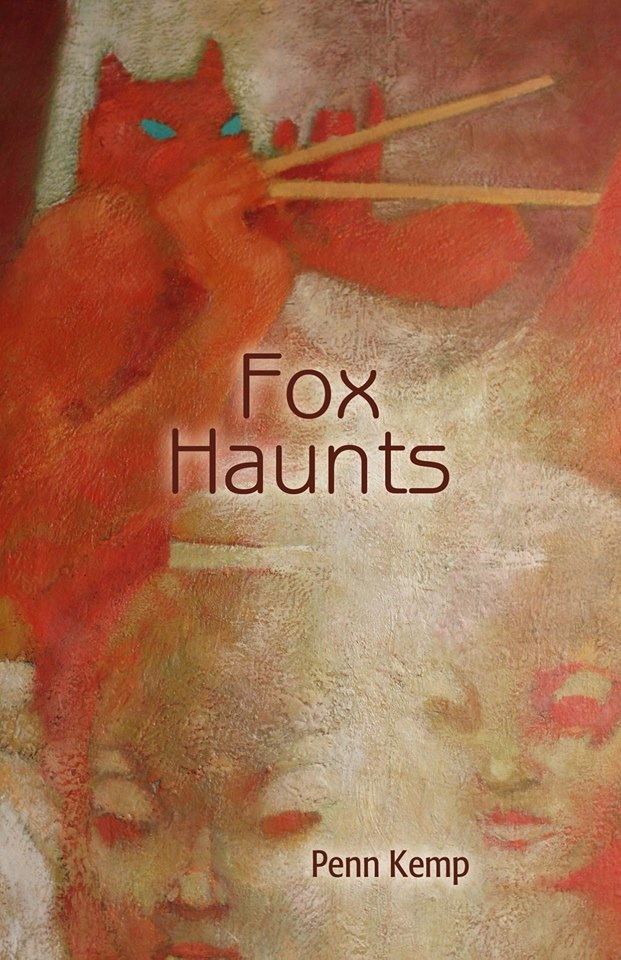By
Jennifer Wenn
Fox Haunts by Penn Kemp is a fascinating investigation of both the real animal and the figure of literature and myth. Kemp’s wordplay, wit and humour are on full display (for example, the whimsical suggestions for keeping foxes out of the yard in How To Repel the Urban Fox), but there are serious streams concerning adaptation, the collision of our civilisation with nature, and what Kemp terms rewilding. This is a captivating, multi-layered work, a demonstration of Kemp’s own precepts: “…Poetry allows for profusion//of voices and multilinear narratives//puns…” (Prompt).
Fox Haunts is divided into four sections: Family Fox-lore, The Urban Fox, Little Literary Foxes, and Dream Frequency. Family Fox-lore consists of two prefatory poems (A Child’s Garden Fox; and Steal, Stole, Stun), family memories that introduce main themes in the work. This starts with a literal collision between human technology (here, a car) and the wild (in the shape of a fox) and proceeds through imagination and a very real fox victim in the form of a stole.
The Urban Fox, Section Two, is the longest one and in many ways the heart of the work. We meet the foxes adapting to and claiming space within our cities, at first just via subtle indications like a rustle in a bush (Ghost Scents), glowing eyes at night (Night Vision; Avoidance Tactic), a slight odour left behind (Natural Magic) or tracks (What Matters; The Beauty of Snowy Waste and Noble Silence; Synecdoche). Later we discover Fox raiding “our pantry, our cat-//food, or cat perhaps” (Be Wilder), urinating on compost bins (Foul Play), raiding a henhouse (Foul Play), keeping everyone awake with screams and shrieks (What the Fox Says), grabbing the family dog by the leg (Foxes I Have Known, Rabid), carrying off defenceless bichons frisés (Why Here, Why Now) or depositing unmatched footwear inside via the cat door (Your Lair Is My Layer, Apparently). We perceive the world through Fox’s heightened senses: hearing (On the Nature of Intelligence; Pointers; Strategies, Night Vision); night sight (On the Nature of Intelligence; Night Vision); seeing the earth’s magnetic field (Strategies). A special mention of At the Moment of Equinox, a lovely hymn to balance and to nature, Fox’s realm.
Little Literary Foxes, Section Three, investigates literature, with touchpoints including Kurosawa (Inari, Kami of Foxes), Ovid (Song of His Origins), the Bible (Samson Agonistes, On Condemnation and Canticles), Milton (Samson Agonistes), Aesop (Fox Fable; Verse, Vice, Virtue), Yeats (Celtic Twilight), The Little Prince (Les Petits Amis), Kim Philby (“The Fox That Came to Stay”), Stephen King & Stanley Kubrick (Eye Shine), Alice Munro (Fair Play on Fur in F Sharp) and more.
In Dream Frequency, Section Four, Kemp, as she has in other works, explores her dreams. Here she finds herself haunted by Fox’s many aspects; a riff on the book title. As Kemp notes in her Introduction “Fox Haunts begins with a play on words. Who’s haunting whom?” We discover Fox and Kemp engaged in a variety of pas de deux: “…You wrap yourself round//in an ourobos of sleep and dream…” (Elementals); “Fox leads me a merry chase as will-of-wisp//streaks across western sky painting random//wisps along cirrus cloud…” (Avoidance Tactic); “We are entangled in tango, not//knowing the steps, not knowing//what trust is, leaning backward.” (Fox Trot); “…I burrow after you into teeming dark” (The Light Breach); “…I stand before you, astonished,//mouth so agape you might well leap down//the little red lane straight into bloodstream.” (Offer).
Throughout the entire work Fox is a liminal figure: “Between discrete realms of possibility” (By her wits, you shall know her); neither dog nor cat (Doubles); inner and outer (Doubles; How to Haunt); literal and figurative (On Condemnation and Canticles); dream and waking (O Fabulist).
An all-important boundary is that between hunter and hunted. When the former, Fox most often victimizes poor Rabbit (How to Hunt; Strategies; Synecdoche; Synopsis, Lady into Fox). Other prey include voles and moles (Night Vision; Strategies); crows (Pulling a Fast One); fowl generally (Pointers; Foul Play); mice (Pointers; On Condemnation and Canticles) and the aforementioned bichons frisés (Why Here, Why Now). In a nice touch, Kemp dreams that Fox and Rabbit are pals (Fox Play).
But while Fox is hunting to feed her family, our civilization all too often turns Fox into the victim, for far less essential reasons: hit by a car (A Child’s Garden Fox; Foxe’s Book of Martyrs, 1563 to the Present); killed for its fur (Steal, Stole, Stun; The Purchase; Fair Play on Fur in F Sharp); starving (“Helpless, Helpless, Helpless”); clubbed to death for raiding a henhouse in search of food (Foxe’s Book of Martyrs, 1563 to the Present); hunted for sport (Foxe’s Book of Martyrs, 1563 to the Present|); used as live torches (Song of His Origins; Samson Agonistes); pushed off a ledge five stories up (“The Fox That Came to Stay”).
Kemp’s prescription for restoring harmony is rewilding, adapting to and drawing from nature what we need, and perhaps have lost: “clarity and strength”, “surrender and acceptance”, “joy and creativity”, “initiation, inspiration”, “your broad view”, “your ground, your holy round” (At the Moment of Equinox). “Reclaim, rather,//and rewild, let’s agree.// //Yes, rewild us for we are//bewildered and beknighted.// //We are precariously tame and//dangerous.” (Be Wilder).
In the final poem, addressing Fox, Kemp expresses wishes and hopes we all could share: “On your own, you’ll do just fine as long//as we humans don’t interfere with your//livelihood, your livelong neighbourhood.// //May you be freed from old mythologies//that call you trickster, demon temptress,//ghost and fraudster. May you run free.”
Fox Haunts is a beautiful, thought-provoking, multi-level meditation, and a heartfelt plea for a reconfiguration of our spirits and a new relationship with the world around us.
Jennifer Wenn
Jennifer Wenn is a trans-identified writer from London, Ontario. In addition to her day job as a Systems Analyst, she has written From Adversity to Accomplishment, a family and social history; and published poetry in Tuck Magazine, Synaeresis, Wordsfestzine and the anthology Things That Matter. She is also the proud parent of two adult children.
Mary McDonald photo
Penn Kemp
Penn Kemp is the author most recently of Fox Haunts (Aeolus House, 2018) and Local Heroes (Insomniac Press, 2018). New eco-poems, including her multimedia collaboration with artist Mary McDonald on www.riverrevery.ca, will be published as River Revery (Insomniac Press, 2019). Quattro Books has published two other works, Barbaric Cultural Practice, and an anthology Penn edited, Jack Layton: Art in Action.



